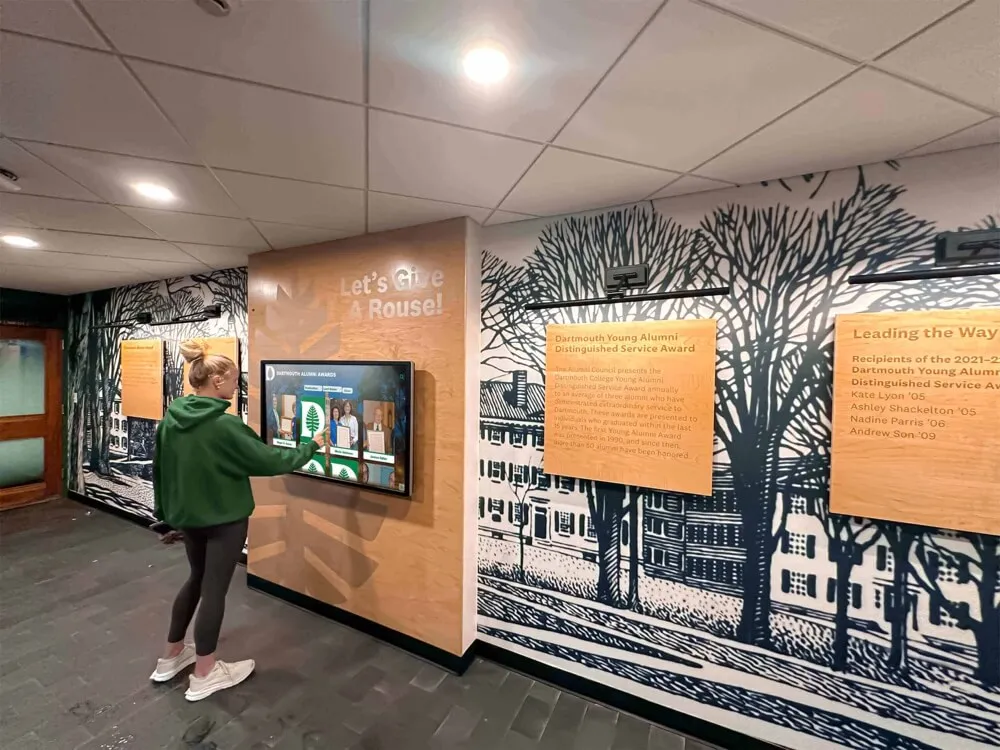Let’s put it starkly: most students walk past university history displays without so much as a passing glance. Those dusty glass fronts with yellowed photographs and faded memorabilia seem more like museum relics from another time than something relevant to contemporary campus life.
But here’s the thing—your university’s history is truly fascinating, and with the right presentation, those displays can be converted into highly sought-after gathering spots that students themselves would want to visit and even share on social media.
The problem is the fact that students feel indifferent to history, and traditional displays rarely speak their language. This present generation of college students has grown up with smartphones, interactive technology, and personalized experiences. They want to interact with content rather than just look at it. So how to bridge this gap to speak of truly interesting shows for university history?
Make Static Displays Interactive
The golden rule in attracting the student’s interest is being able to touch, have fun, or do something with history. Instead of just reading about the university being established in 1887, imagine the students swiping through an interactive touchwall covered timeline to see images of changing campus fashions and slang through the decades alongside its social life. So localizing that interaction converts passive observers into active actors.
With these types of interactive digital displays, students may familiarize themselves as deeply as they want with any topic they find fascinating: for example, one engineering student might spend 20 minutes looking into patents described by alumni inventors; a literature student would be reading old student newspapers’ extracts for an hour.
The beauty of interactive technology is to individualize society in such a manner as to allow each visitor to carve their own niche through your institution’s past.
Celebrate Student Achievements Across Generations
A big suggestion to use history as a tool to address felt issues is to link historical achievements with opportunities of the present day. A well-planned wall of fame populated with distinguished alumni showcases revolutionary student research and notable accomplishments, establishing a shared legacy in which the current students already see themselves.
Once freshmen notice that their lecture halls have been occupied by a Nobel laureate or that next door to their dorm room, an enterprising fellow student processed their first deal, and it suddenly becomes personal and endearing to history.
But here’s the trick: don’t only focus on household names. Include a variety of accomplishments that reflect different ways of getting there. Showcase the social worker who reformed community services, the teacher who created novel methods of teaching, and the artist whose art adorns national galleries. This kind of acknowledgment records for students that there are many ways to attain greatness and that their own unique achievement is a legitimate contribution to the group’s history.
Gamify Learning
Any group of students will really get excited if gathering historical information becomes a game. Create a scavenger hunt across the campus where students use their phones to look for QR codes cleverly hidden near historical sites. Each code then unlocks a story, a video interview from an alumnus, or some trivia that will help the players solve a big-picture mystery related to the history of their campus.
Establish a point system for students to gain recognition by studying various aspects of the university’s history. They may be collecting “Decades” badges for exploring confounding content from various periods or “Innovators” badges for learning about significant alumni contributors.
Having a leaderboard, challenges, and prizes will fuel the competitive nature of the students while making history feel like a quest, as opposed to a task.
Bring History to Life Through Storytelling
Numbers and dates do have their place, but it’s stories that really resonate with us. Instead of noting when a building was built, reveal a tale or two about the drama, humor, or human experience involved. Did the students stage protests to save the beloved oak tree? Was there an epic rivalry between dorms? Did someone famous show up for a last-minute show in the quad?
The voices of history can be heard through audio recordings, video testimonials from alumni, and first-person perspectives. The firsthand voices that students hear of people living through great campus moments—be it the integration of the university, protest movements in the sixties, or coed dorms awakening from being coed for the first time—would make history less abstract and more emotional.
Create Opportunities for Student Contribution
The most engaging displays are the ones students help create. Invite current students to interview alumni, curate exhibits, or add their own reflections on how they’re experiencing pivotal moments right now. After all, today’s breaking news is tomorrow’s history. A student-curated exhibit on how the university community responded to recent challenges gives current students ownership over the historical narrative.
Create and set up a digital platform where students can submit their own stories, photographs, and predictions for the future. This will help to create a living archive that keeps on growing to date and constantly reminds everyone that they’re not just observing history—they’re actively shaping it. When the students see their contributions alongside historical content, it breaks down the artificial barrier of “history” versus “now.”
Make It Social Media Worthy
Let’s face it: so many students pass stuff that is not Instagram-worthy from one hand to another. Keep photo ops in mind while designing display modules. Design vintage photo filters that students can apply to themselves and see what they’d look like in yearbook photos from a couple of different decades.
Enable augmented reality experiences where students can stand next to a holographic rendition of an iconic alumnus or find out how campus buildings used to look in the good old days when they point their phones at certain locations.
The more student-history displays can be shared, the more naturally they will be dispersed in the student population. Students posting on their interactions with displays are not only promoting the exhibits but also placing ownership in their connection to institutional history.
The Bottom Line
Getting students to engage with university history is not about making it “trendy.” Instead, students ought to understand that they are part of something bigger than themselves.
Probably with interactive technology, an inclusive form of storytelling, gamification, and outlets for individual contribution—all these features in an overlooked display area are converted into exciting foibles where the student engages with the university’s legacy and views themselves in that legacy.
The purpose is not simply to teach students about history; it is to get them to belong to it. Now, that is something worthy of a stop to explore.














